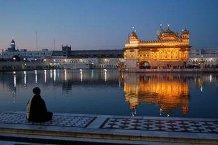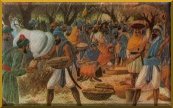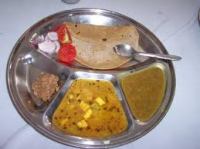BANISH HUNGER WITH POWER OF DEVOTION IN THE SIKH’S WAY
April 13, 2012
Wars are going on all over the world; population increasing at an exponential rate; food production not increasing at same rate; specter of mass hunger not far; rich eat too much and throw away un-eaten food; poor have to scavenge; homeless and poor frustrated; politicians ever busy playing their self aggrandizement games; unheard of things happening due to hunger and poverty; as long as the belly is full, chances of crime are less.
I heard from a Sikh Saint long time ago, “Peace would descend upon earth when several Langars shall run.” (Langars are kitchens serving free food (vegetarian only) in the Sikhi way -the Sikh code of conduct) Perhaps the time come to divert money from weapons of destruction to free food?
Guru Nanak, the First Guru of the Sikhs, foresaw the future of mankind and started the Langar system 500 years ago.
The Sacrament of Langar has two important features: the Sangat (congregation of devotees of the Guru) and the Pangat (row of seated people in the Langar). ‘Guru ka Langar’ meaning the Guru’s Langar is a symbol of equality, fraternity and brotherhood: the high and the low, the rich and the poor, the learned and the ignorant, kings and paupers, all share the same food sitting together as equals thus creating social equality.
The word ‘Langar’ is from Persian language meaning an anchor; a stay or a rope for the tent; the shrine of the Sufi Order; an alms-house. Punjabi, the language of Punjab state of India, is a mix of Persian words besides Sanskrit and other languages. The word ‘Punjab’ itself is a Persian word meaning ‘of the five waters’: the land is intersected and watered by five rivers.
After the Langar system was started, Guru Amar Das, the third Guru in succession to Guru Nanak, strengthened it and asked the Sikhs to make voluntary contribution in cash or kind as their religious duty. Since then, Langar has been central to Sikhi. And it’s a sin for a Sikh to question a man’s faith and creed before letting him sit and eat there. At every Gurdwara (the Doorway to the Guru as the Sikh shrine is called) howsoever small, a meal is always shared with others regardless of religion, caste, skin-color, creed, age, gender or social status.
Emperor Akbar, the third ruler of the Mughal dynasty who had a secular leanings compared to his diehard Mullahs, once went to meet Guru Amar Das for his blessings. The Guru had stipulated that if someone wanted to behold him for whatever reason, he or she must first sit with the common people to eat food in his Langar. Emperor Akbar was humble enough to abide by the Guru’s dictate. After eating he said, “Never have I ever tasted such a simple and delicious food from my royal kitchen where 36 different dishes are made everyday.”
The largest Langar system in the world is run at Harmandir Sahib meaning ‘the abode of God’ also called the Golden Temple complex of the Sikhs at Amritsar in the Punjab.
The sublime beauty of Harmandir Sahib or the Golden Temple
Before I write about the largest Langer system in the world, let me put a few facts in the right historical perspective. Most poorly informed people often mistake the Sikhs for Hindus because of their similar sounding names, which they are not. And others mistake the Sikhs for Muslims because of their turban, which they are not. Turban is an honorable headwear for all men from South and Central Asia. While Hindus and Muslims may not be wearing the turban now for personal reasons, but all practicing Sikhs will wear it forever. And it’s important for my readers to understand why the Harmandir Sahib is called Golden Temple and why the Sikhs are not Hindus? The reason has a historical background.
When Maharaja Ranjit Singh got the Harmandir Sahib gold-plated in 1815 English travelers began calling it the Golden Temple. The word ‘temple’ gives a false impression that the Harmandir Sahib is like the temple of the Hindus, which it is not. The Sikhs do not worship statues and the Harmandir Sahib does not have any statues of gods and goddesses. Sikhism is monotheism and the Holy Scripture of the Sikhs -called Guru Granth Sahib- is the fountain of Gods’ Word. Installed in the Harmandir Sahib on a prominent pedestal the ‘Holy Scriptural Guru’ is read and venerated through out the day as devotees carry out obeisance to it. A team of Kirtanias -professional singers of devotional hymns of the Guru Granth Sahib- sing the praises of God Almighty accompanied by musical instrument: each team performing for a two hours stretch starting at 3 in the predawn hour and carrying on through out the day well into the night.
The Guru Granth Sahib is a compilation of devotional hymns to the formless God. The hymns were composed by the Gurus themselves as well as by other Saints from the full spectrum of the Indian society: from the highest to the lowest castes of the Hindus as well as by a Muslim Saint of Punjab. The fifth Guru collected such devotional hymns and compiled them according to their Hindustani Ragas –a complex musical system of melodious notes, rhythms and their meters.
The Guru Granth Sahib, the eternal Guru
Having briefly informed my readers about the Harmandir Sahib and its devotees, let us come back to the Langar which is located in a building on the southern edge of the Holy Sarovar, the water tank which surrounds the Harmandir Sahib or the Golden Temple.
At a time over 3,000 people are served vegetarian food on the two floors of the Langar building. On an average, 40 to 50,000 people eat free food every day all the year round. The number exceeds 100,000 on Sundays and special religious days. And despite all the free food, even if people of non-Sikh origion come to eat -which happens everyday- they are most welcome. And there is no coercion or compulsion or proselytizing to influence them to join Sikhism. That is because all the Gurus have stipulated, “Sikhs must live an exemplary life themselves and if others feel motivated on seeing their conduct they may come into their fold if their Karma (deeds of past lives) earns them salvation through the Guru.” All the ancient Indian scriptures stipulate that it is only your true Guru who will adjudicate on your behalf so that God may consider setting you free from the cycle of reincarnation.
People being served free-food and Langar of the earliest times
For a moment, if we can leave aside our personal religious beliefs and differences, it’s indeed amazing to see the devotion and selfless service of the Sewadars –the permanently employed service-hands as well as a large number of men and women volunteers. They work to knead dough, cook food, serve people, wash and wipe the used utensils and swap the floor before the gates are opened for the next batch to sit and eat.
Roties being stacked away before serving
With the passage of time an elaborate arrangement has come up to cook and serve food for such a large consumption. There are two kitchens which have eleven large sized Tawis -hot-plates, several gas burners, machines for sieving and kneading dough and several utensils for cooking. On one Tawi 15 people can work at a time. It is a chain process: some make Pedas -balls of dough; others roll them into rotis -Indian flat bread; a few put them on the hotplates; others work with long iron rods to toss them over till they are done and then they are stacked away to be served.
On one Tawi, over 20 kgs (44 pounds) of flour is used in two hours. The kitchen also has a Roti-making machine donated by a Lebanon-based Sikh which is used only when large crowds was expected. The Roti-making machine uses 20 kgs flour in half an hour. To feed dough to the machine, two kneading-machines knead one quintal (100 kilograms) of flour in 5 minutes.
The Roti making machine donating by a Labanon-based Sikh
With the donated cash, the Management buys raw material in bulk for a two months requirement besides a large voluntary contribution by devotees.
A normal thali (Indian plate) of Langar food Langar of Sikhs living out of India
The daily consumption is about 50 quintals wheat, 18 quintals Daal -lentil, 14 quintals rice, seven quintals milk, 6 quintals sugar, 20 kgs tea leaves, 50 kgs Desi Ghee -purified butter, 10 kgs of condiments and over 100 gas cylinders.
A documentary titled “Golden Kitchen” was made by Belgian film makers, Valerie Berteau and Philippe Witjes. The film impressed audiences at numerous film festivals in Europe. On June 6 2009, it was adjudged ’Outstanding’ at the Festival of Short Films organized at the New York Museum of Modern Art. Critics have praised the film for bringing out the beauty of “an endeavour that is remarkable in scale, the clockwork efficiency with which the kitchen is organized and the fact that all the people manning the kitchen are volunteers who are inspired to undertake the heavy labor by their religious conviction.” It wouldn’t be possible without people who look for no other return except Wahegurus’ –Gods’- blessings.
And the Sewadars keep offering a second and a third helping while at the same time telling people not to waste any food, being a gift from God for our sustenance.
The Great Gurus had coined several maxims to motivate the Sikhs into dynamic action. These maxims are part of the daily prayer and devotees recite them as they go about working in the Langar thus blending the power of prayer into the food. No wonder Emperor Akbar said, “Never have I ever tasted such a simple and delicious food from my royal kitchen ……..” The maxims go, “Loh langar tapde rahin” (May the hot plates of the Langar remain ever hot) “Khavo kharcho rall mil bhai, Totth na aawaey vadhdo jayee” (Eat and share with others, oh brothers! It will always increase, never runs short)
The Gurus had personally set the example of selfless service
How I wish the misguided Islamist and those oil rich countries which give them money to kill innocent people in the name of Allah, could see the documentary titled “Golden Kitchen”. And if they divert the money to run free kitchens instead, I am sure they will go to heaven on the day of Kayamat (the doomsday).
Since other major religions of the world don’t have the Langar system built into their faith, perhaps they may consider diverting money to the Sikhs for free food for everyone. If they do so then Guru Nanak would put in a word to God or Allah -whatever you want to call Him- to send them all to heaven. After all Guru Nanak is revered as Peer Baba Nanak by many Muslims and his wooden sandals are preserved in Mecca. He preached all over West Asia 500 years ago, including Jerusalem, Lebanon, Sytia and Turkey.
If everyone can cooperate with the Sikhs to make the world a happy and content place, Gods’ cause would be better served. And if God Almighty so desires, it shall happen as the Sikh Saint had once predicted.









